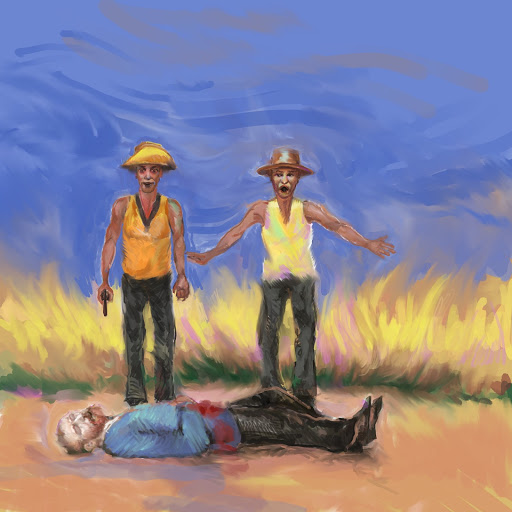The secretans
the teen hooligans from paris
Who might have been responsible for the death of Vincent van Gogh? We would be remiss not to at least consider the role of the Secretan brothers, seventeen-year-old René and nineteen-year-old Gaston, since they top the list of suspects for some investigators. The brothers were from Paris but visited their wealthy father’s family villa in Auvers every summer. They, along with other hooligans, often pulled dangerous pranks on the eccentric and lonely Vincent, knowing that they would likely not face repercussions for their actions, and then they would buy him a drink. René in particular was known to have bullied Vincent during his time in Auvers in the summer of 1890 and also to have threatened him with his gun. He had access to his own revolver, a .380 pistol. René was named in a 2011 publication as a suspect directly involved with the shooting of Vincent.
There was no obvious intent or motivation, but the brothers did have opportunity to commit murder, with their often frequent interactions with Vincent and known access to a loaded gun according to one critical interview. Given their record of behavior and their sudden departure from Auvers soon after Vincent’s death, they are likely suspects for any possible wrongdoing, either accidentally or on purpose. Whose gun was it—did it belong to René back in Paris, or did he acquire it from Gustave Ravoux in Auvers as has been speculated? Is it possibly the same old revolver that was found rusted in the field in the 1950s? No one seems to have any answer to these important questions except further unsubstantiated speculation. Of course, if René and Gaston were indeed responsible, that means Vincent lied about their role, never naming them as the cause of his wound. Why would Vincent have wanted to accept blame and protect these kids?
Reenactment: The Secretans Wound Vincent
What follows is an artistic suggestion and a re-enactment of what might have played out if indeed the Secretans were directly involved in Vincent’s fatal injury.

It’s July 27, 1890. Vincent is placidly painting in a wheat field at the base of the Chateau Auvers or any where near the Ravoux Inn. as the Secretan brothers approach, verbally abusing Vincent while brandishing their “pea shooter” revolver

Upset by the continued verbal abuse and trying to protect his wet canvas, Vincent begins arguing with René. An altercation ensues as René charges and knocks over Vincent’s easel and canvas. Vincent responds as René pulls his gun, and Gaston is aghast

As René points his gun at Vincent, Vincent responds unexpectedly and moves toward him in an effort to stop the threat. In the tussle, René falls back and his firearm discharges, hitting Vincent in the stomach. Was it an accident, or intentional

The two boys realized what they had done and began to panic and argue. They start running away and then throw the gun out into the middle of the field, as far as they can fling it.

In this reenactment of the murder, René was most likely tormenting Vincent wherever he had set up his easel and canvases for the day’s work. That very special spot is where his easel, canvases, supplies, and palette should have been found, that day or when the police superficially investigated after his death. Obviously, someone found most of it and brought it to Vincent’s funeral, except his last painting, but did not tell anyone the details that would be needed to determine the scene of the crime with any degree of certainty. The Secretan brothers may have brought back his easel and all his art to the Ravoux Inn, but what happened to his last canvas? Is this likely what really happened? There are still too many unconnected dots. This scenario just does not all comfortably fit together regarding motive, location, witnesses, the missing art equipment, and the “last canvas”.
Maybe the Secretans panicked in the heat of the moment of a possible accident or a real crime, and in their attempt to hide their involvement, if any, they got rid of their tiny Lefaucheux pistol. They threw it out into the middle of a field, as far away as they could throw it from the crime scene, only for it to be found about sixty years later by a farmer, all rusted, the wooden grips disintegrated in the dirt. Now they are the prime suspects in killing Vincent in the widely discussed appendix of Naifeh and White-Smith’s mega-biography, Van Gogh: The Life (2011). They did apparently leave Auvers the next day, a month before their normal expected family departure. How believable is this scenario? René Secretan, when interviewed during the Vincent hullabaloo (around the time of the 100th anniversary of the artist’s birth, and the filming of Lust for Life), said he did not do it, but did admit that the murder weapon was his gun and that Vincent took it from his hunting bag. If this is all correct, then the missing magic bullet should be a .380 round (or 0.355 inches and known as a 9mm “short”), as Secretan admitted it was. The missing, “magic” bullet still holds the key to whose gun may match the bullet remaining in Vincent or his casket. In addition to pointing to who may have murdered Vincent accidentally or on purpose, the missing bullet, if found, may also be able to eliminate a suspect and clear the Secretans’ names and also disprove the knife theory.
